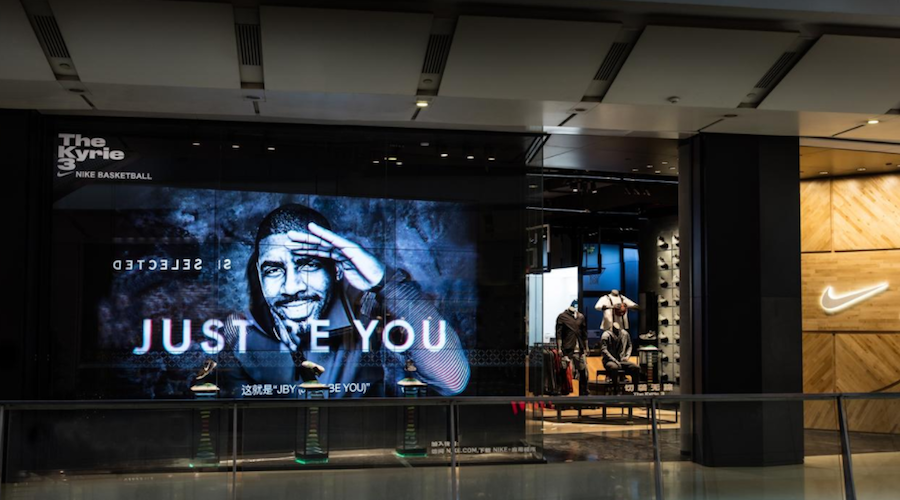Blaming the repercussions of the digital shift at retail, consolidation well beyond the sporting goods channel and an increasingly promotional climate, Nike Inc. cautioned that Nike Brand’s sales could slow in the near term in North America.
“The North America retail landscape is not in a steady-state,” said Andy Campion, EVP and CFO, on the company’s third-quarter conference call with analysts. “Digital disruption and other dynamics are resulting in more aggressive promotional activity than we expected 90 days ago. So we are going to remain tight, with respect to the supply that we are putting into the North America market in the short-term, while aggressively driving the initiatives that will reshape and grow the market, and extend Nike’s leadership long-term.”
Specifically, he said Nike will be “measured in the short term in Q4” given the heightened promotional climate amid the ongoing digital disruption.”
“Based upon the breadth and depth of our portfolio, we anticipate that the currently dynamic overall retail marketplace will create both puts and takes in the short-term,” said Campion. “So we are being appropriately measured with respect to our Q4 financial targets for North America. We will keep supply tight, maintaining the strong foundation we’ve created, while we bring new innovation to market and accelerate more direct consumer connections.”
Overall, Nike officials said demand for Nike Brand remains healthy in North America and asserted the region delivered a solid third quarter given challenges at retail.
Revenue grew 3 percent on both a reported and constant-currency basis. Growth was balanced across both footwear and apparel, highlighted by another quarter of strong growth in Nike Brand sportswear and the Jordan Brand. A continued bounce-back in the basketball category also helped.
EBIT growth of 9 percent outpaced revenue growth due to gross margin expansion and SG&A leverage. Inventory declined 8 percent.
The region has successfully rebalanced inventories after finding inventories were running too high in the first half of calendar 2006. The reasons for the elevated inventories were traced to the West Coast port congestion, issues in its North America distribution center, third-party retail discontinuities, and lower-than-expected sell-through last year on some signature basketball styles.
“We continue to make great progress in North America, rebalancing supply and demand, reigniting momentum in our basketball business and sustaining momentum in sportswear,” said Campion.
Trevor Edwards, president of the Nike Brand, likewise assured investors on the call that demand for Nike brand in North America “continues to be incredibly strong.”
He noted, for example, that Nike’s SNKRS app continues to see launch products “sell out rapidly” as they become available and that its Nike Run Clubs at its urban locations continue to regularly draw runners. He cited sales momentum with its partnership locations such as Foot Locker’s House of Hoops and Fly Zone as well as the Fieldhouse at Dick’s Sporting Goods. Finally, he highlighted how special product drops and targeted retail executions raised the brand’s’ profile during New York Fashion Week and NBA All-Star Weekend.
He added, “While we’re seeing consumer traffic patterns shift by digital disruption, retail consolidation and increasingly promotional environments, this geography continues to move in the right direction.”
One weak category in North America, Edwards admits, is running, although he sees “accelerating growth” ahead with the rollout of Air VaporMax to more models as well as two more cushion-focused platforms being launched this year.
Overall, Mark Parker, Nike Inc.’s CEO, said in the Q&A session that the disruption at North American retail creates “some big opportunities and some challenges at the same time.” He stressed how Nike is taking steps to double the output and cadence of new products, accelerate its speed to market and better connect with consumers across digital platforms to be more responsive to consumers’ demands.
In his opening statements, Parker had revealed a “triple double” program whereby Nike plans to double down on its investments in innovation, supply chain and connecting with consumers.
“I think the important thing to point out is that these changes are really being driven by the consumer, and consumer demand at the same time remains quite strong,” said Parker in the Q&A session. “But we know that consumer expectations are quite high in terms of product, the type of product they want, the innovation, the style. They want the product fast, they want it easy, they want personal service. So these are all things that are driving some of these shifts in the marketplace.”
Parker added about the North American region, “It’s a market that’s undergoing a lot of shift and change, but again, I wouldn’t trade our position with anybody. I think we’re in a strong position to leverage our strength as a brand, as a company and we expect to do that.”
Photo courtesy Nike
















